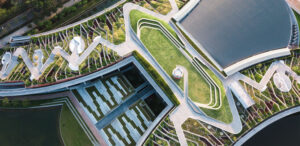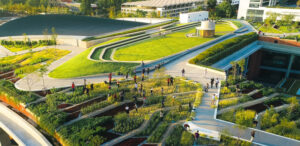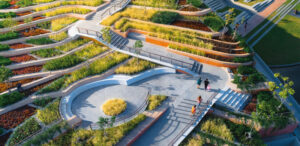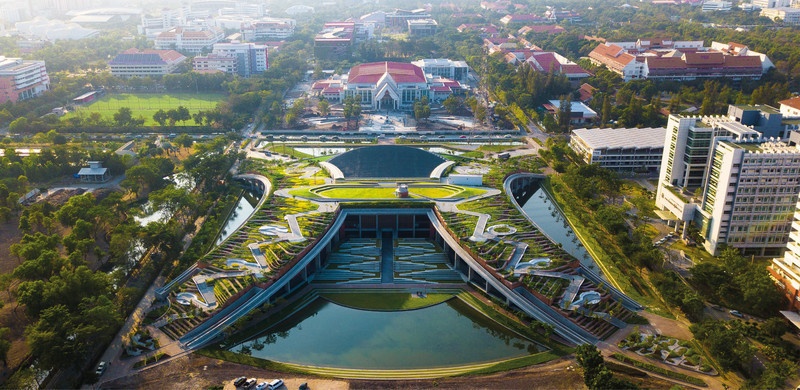In the Khwaeng Wat Bowon Niwet neighborhood of Bangkok, Thailand, Thammasat University‘s gorgeous rooftop urban park is helping to feed the city, while educating the public in a hands-on manner about traditional agricultural practices.
It was designed by LANDPROCESS, a Bangkok-based landscape architecture and urban design firm founded in 2011 by landscape architect Kotchakorn Voraakhom.
 Repurposing 236,806 sq. ft. of wasted rooftop space, Thammasat University introduced an adaptive climate solution with Asia’s largest organic rooftop farm—Thammasat University Rooftop Farm (TURF).
Repurposing 236,806 sq. ft. of wasted rooftop space, Thammasat University introduced an adaptive climate solution with Asia’s largest organic rooftop farm—Thammasat University Rooftop Farm (TURF).
TURF grows more than 40 edible species, including rice, indigenous vegetables and herbs, and fruit trees. Ranging from water-tolerant to drought-resistant, each suits the unique microclimate created by sunlight exposure, curvature, water flow, roof’s elevation, and its wings.
TURF provides up to 20 tons (80,000 meals) of organic food each year. The campus canteens complete the sustainable food production system from start to finish, reducing CO2 emissions and waste as compost to fertilize crops for the next harvest.
 Thammasat University Rooftop Farm provides a platform to learn and share across various disciplines. Through year-round workshops on sustainable agriculture, it leaves newfound knowledge for 40,000 campus residents and the surrounding community to use at home.
Thammasat University Rooftop Farm provides a platform to learn and share across various disciplines. Through year-round workshops on sustainable agriculture, it leaves newfound knowledge for 40,000 campus residents and the surrounding community to use at home.
At the entrance, a terraced amphitheater welcomes everyone, designed with universal outdoor access to the second-floor auditorium. The life-size sculptures of the University’s two founders bring back their presence and the principles of the institution’s democracy and sustainability.
TURF rewards those who climb to the top with a 360-degree panoramic view of the university centered in the urban farm with open sky. A large amphitheater provides an accessible and flexible recreational and educational space for all visitors.
Carried on through several generations of farmers who learned from the land and water they lived with—TURF encapsulates the history of Thai agriculture, landscape and native soil, embedded as lessons to adapt to and embrace for climate challenges.
Integrating landscape architecture with the ingenuity of traditional rice terraces, TURF incorporates sustainable food production, renewable energy, organic waste, water management and public space.
 The mound shape architecture pays respect to the university’s former director, Dr. Puey Ungphakorn. “Puey” means “mound under the tree,” or “nourishment,” in Thai.
The mound shape architecture pays respect to the university’s former director, Dr. Puey Ungphakorn. “Puey” means “mound under the tree,” or “nourishment,” in Thai.
With an earthwork of rice terraces and modern green roof technology, the cascading rooftop absorbs, filters and slows down runoff 20 times more efficiently than conventional concrete rooftops. As rainwater zigzags down the slopes, TURF grows food to feed the campus. At the end of its journey, four retention ponds await on each wing, mitigating and storing excessive rainfall for future use during drought.
Carving into the mountainous architecture, TURF maximizes the terrain to create multi-functional public spaces, and a large amphitheatre with a 360-degree panoramic view of Bangkok. The roof is equipped with solar panels, capable of producing up to 500,000 watts per hour to irrigate the urban farm and power the building beneath it.
As the lush green seasonally turns to dry brown, TURF is a realistic, but hopeful solution, putting urban dwellers back in tune with agricultural practices. Amidst the climate crisis, food and water scarcity pose tremendous threats to human civilization.
Once abundant agrarian societies, Bangkok and cities across Southeast Asia, have fallen victim to unregulated urbanization. To prioritize global food security, and the health of our people and the environment, cities must utilize neglected spaces to efficiently and sustainably produce food.
Lessons on Thai agriculture, landscape and native soil are embedded into TURF, educating future leaders to adapt and embrace climate challenges, by building regenerative, resilient, sustainable cities for generations to come.

